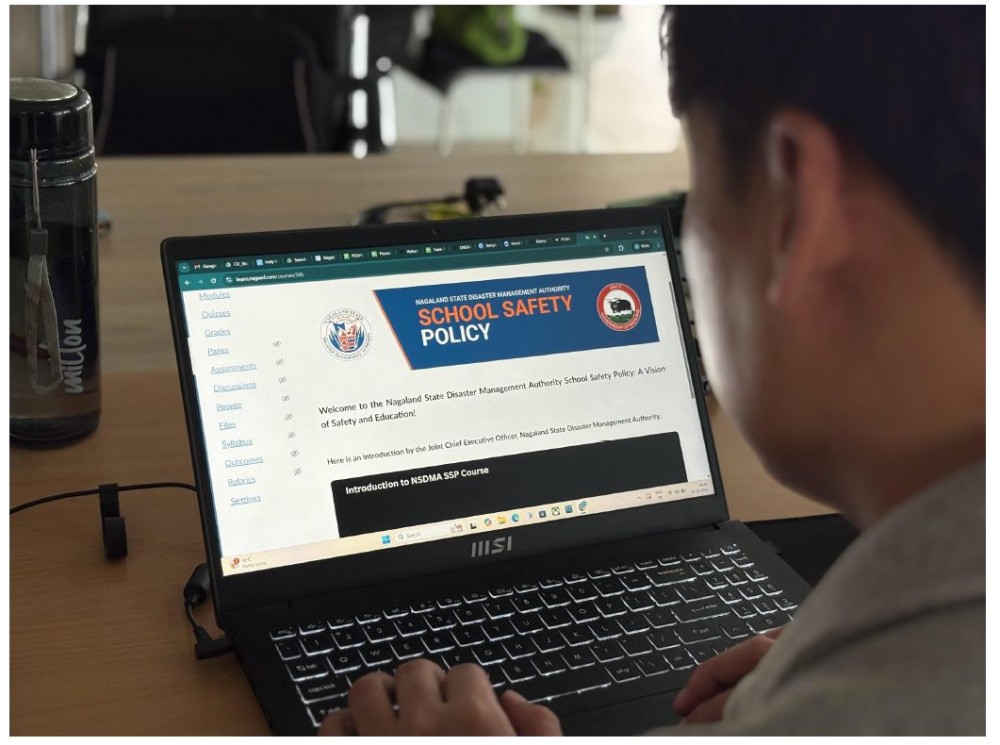Users participates in the online School Safety Policy modules on his laptop

NDMA’s 2016 Guidelines and the Disaster Management Act Make Compliance a Legal and Moral Imperative
NagaEd
Kohima
The safety of children in schools is no longer just an aspiration, it is a national mandate. In light of the increasing number of school-related disasters in India, from fires to earthquakes and floods, the Government of India and the National Disaster Management Authority (NDMA) have reaffirmed that every school in the country must comply with the National School Safety Guidelines (2016).
These guidelines, framed under the Disaster Management Act, 2005, make it a statutory requirement for all schools — government and private — to develop comprehensive disaster management plans, conduct regular drills, and train teachers and students in emergency preparedness. The Act’s Section 39(a) mandates that State Departments take proactive measures for disaster prevention, mitigation, preparedness, and capacity building in accordance with the national framework.
A Legal and Administrative Framework for Every State
Recent directives from the Department of School Education & Literacy (DoSEL) and the NDMA have underlined the seriousness of implementation. States and Union Territories have been instructed to:
1. Prepare State and District Action Plans with clear timelines for enforcing the School Safety Guidelines.
2. Appoint dedicated Nodal Officers for school safety at both the State and District levels to oversee and report compliance.
3. Ensure oversight by District Disaster Management Authorities (DDMAs) under Section 25 of the DM Act.
4. Submit quarterly compliance reports to the NDMA and DoSEL for national review.
These directives follow findings from NDMA’s pilot firefighting drills in schools across six
States (March–April 2025), which revealed serious preparedness gaps:
• 86% of schools had not conducted mandatory biannual fire drills.
• 62% lacked evacuation plans.
• 44% had no fire safety certificates.
• Only 28% of schools had provided fire safety training to staff and students.
These alarming statistics reaffirm that ensuring safety in schools is not just a compliance task, it is a matter of urgency and responsibility.
Nagaland’s Proactive Model: Turning Mandate into Movement
Amidst this national mandate, Nagaland has emerged as a leader in putting the NDMA’s School Safety Guidelines into action.
In 2023, the Nagaland State Disaster Management Authority (NSDMA), in collaboration with the Department of School Education (DoSE) and NagaEd, launched the Nagaland Disaster Management School Safety Policy (NDMSSP) Compliance Course — a first-of-its-kind digital initiative designed to help teachers and schools meet these national requirements effectively and meaningfully.
So far, over 10,000+ teachers across Nagaland have registered under the programme — marking a significant step toward universal preparedness in the education sector. The School Safety Policy Compliance Course (Phase 2) is currently open for all educators across Nagaland. Schools and teachers are urged to register and complete the course before October 31, in alignment with NDMA’s statutory requirements.
To register, visit the Department of School Education, Nagaland website.



